Experience how game theory can help your trading by considering and following major players and their money moves. Our Algorithms make it visible to you, so you can trade what you see!
Game theory studies strategic decision-making: It helps analyze traders’ behavior in the financial markets. By understanding traders’ strategies and tactics, game theory can help investors make better decisions and improve their trading performance by analyzing the behavior of dominating market participants like institutional investors or market makers. Additionally, game theory helps develop trading strategies considering other market participants’ behavior.

Game theory seeks to explain the mathematical and psychological factors driving the decision-making of independent actors in a competitive setting. The concept is based on the premise that rational players in a game or a situation aim to maximize their payoff/profit and minimize their losses. It also looks at how these players make decisions in response to the different strategies employed by their competitors. The results of these analyses help predict human behavior in a strategic setting. For transferring this theory to the trading environment, we first describe variables influencing decision-making and the price prediction resulting from the analysis.
Variables in the Game Theory of Trading
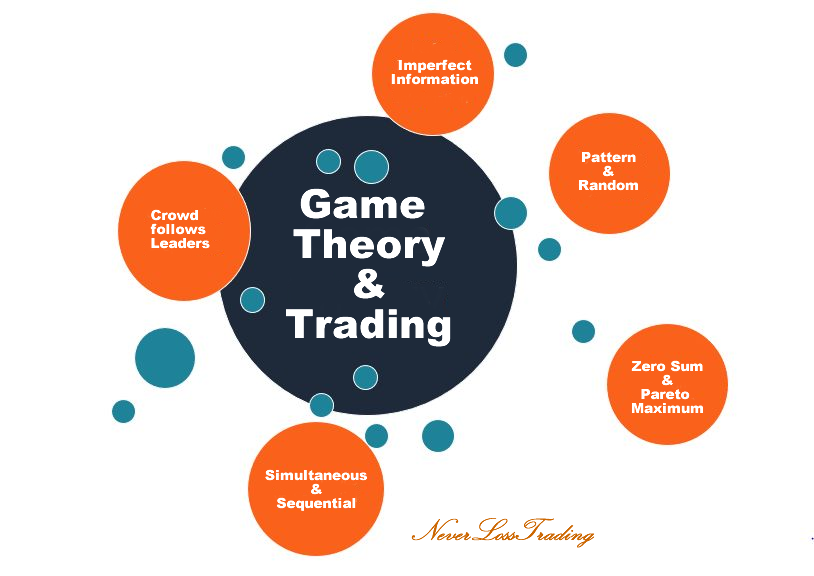
Before the following investment taces with our algorithms, let us describe the players and their behavior:
The Crowd follows the Leaders
Institutional investors transact the vast majority of trades in the financial market. Who are those, and what is their intention?

Without naming all the players: a smaller number of investors influences many followers and the gatekeepers intermediate, while some players act in all three segments listed: like being pro traders, acting as market makers, and offering funds. By the sheer size of their investment, key influencers and followers leave a trace of their actions that you can spot and follow as a retail trader with the right tools. The Apple Inc. chart shows the price development between December 2023 and March 3, 2023. We will explain how we follow price signals institutions initiate, where our indicators measure underlying changes in supply/demand and formulate price move indications.
AAPL on a Daily NLT Top-Line Chart

The chart shows six potential trade situations with simple rules:
- Do not enter at the exit level
- Take profit at the dot on the chart
- Do not open trades in NLT Purple Zones
- Only trade when the spelled-out price threshold is surpassed in the price movement of the next candle
Situation-1: At the end of the NLT Purple Zone, Sell < 133.73 printed and was confirmed, leading to a trade to the Purple dot on the chart (target), and we disregarded the sell signals that came after, took profit and got ready for the next indication.
Situation-2: Two Buy > signals confirmed the next candle’s price movement and came to target (second blue dot in the sequence).
Situation-3: Buy Signal after the earnings conference, strong price move to the target.
Situation-4: Price drop after the dividend payout, as expected, so we disregard this signal
Situation-5: Confirmed sell signal, and we exit at the target dot.
Situation-6: Buy signal to be confirmed.
Imperfect Information
As good as you are informed, you will never beat the best analysts institutional investors employ. However, suppose you focus on the trace institutional decisions leave. In that case, you can act as a follower with an edge, getting in and out of entire positions faster than institutions can do.
Simultaneous and Sequential
When you act in the markets, you act simultaneously and sequentially after you receive an indication from your system where a price move might lead. So do other market participants; you must give yourself enough time to make proficient decisions under time pressure. Hence, if you want to day trade determining short-term what you want to do, you need to be highly trained and solid in your decision because you also trade against computers that are programmed and act to win. However, all is doable, but you will not beat a chess computer without knowing the game, and neither will you beat a trading computer without an adequate strategy. Price move indications are critical; however, applying essential trading strategies that allow you to act risk-limited and with leverage enables you to follow price moves to the up or downside from any account.
Pattern and Random
Most of the time, price development follows a pattern; however, there are times when it is random, and before acting, you must find a way to decide for the circumstances under which you operate. The system you use needs to deliver the decision-making base because guessing is not a repeatable principle that will give you an edge over others prepared to take your money. We follow historical price patterns and news-driven events. Earnings are a typical news-driven event. Hence, prepare and be aware of knowing about critical times to act so you are well prepared for trading; if you guess, your success will be random or nonexistent.
Hundreds of companies quarterly report earnings and initiate price moves you can spot and follow. We prepared a short guide on acting best by trading in and out of earnings conferences.
If you like to read the details, write us an email, and we will send you the strategy write-up:
contact@NeverLossTrading.com Subj.: Earnings
Zero Sum or Pareto Maximum
Zero-sum describes a situation where the total of the gains and losses of the players are equal. For example, a game between two people where one person wins $100 and the other person loses $100. On the other hand, a Pareto maximum is a situation in which gains or improvements made to one player do not come at the expense of another. This means that the total sum of the game can be greater than zero, meaning both players can benefit from the outcome of the game. We could run an extended theory, but we believe in the Pareto Maximum. Just think of all the additional government money printed that ended up in the financial markets as investment potential and drove the markets up; even so, we are now facing a time of a slight pullback.
Game theory is based on the premise that rational players in a game or a situation aim to maximize their payoff and minimize their losses. It also looks at how these players make decisions in response to the different strategies employed by their competitors.
When operating in the stock market at a 50/50 game, you will not have a chance to succeed long-term. Most retail traders never reach a decision-making base better than 55%. However, dwell on what this means:
- With a 55% system, the odds are in your favor; however, winning six out of 10 trades based, your system probability is only 50.4% or random
- If you work with a system that provides 65% forecasting accuracy, you have a 75.1% chance to win six or more trades out of ten, and now you have an edge.
These statistical facts are the brutal truth many retail traders now want to accept. If you invested $500 in your college education, how likely was your chance of making $100,000 a year from it? Knowledge and skills are needed to succeed. If you operate on a 50% chance, the likelihood for you to lose four trades in a row is only 6.25%. Hence, many retail traders celebrate occasional wins but do not follow a system that produces a high probability of a successful outcome.
You must run with a system that gives you high-probability trade setups to bring the odds in your favor. Retail traders without a high probability system fail because they lack the knowledge and experience to make informed decisions. Without a system to guide them, they are likelier to make mistakes and take too much risk. They may also lack the discipline to follow their trading plan and rules. Without a system, they may be more likely to chase losses or take on too much risk to compensate for losses. High-probability trading starts when a system can identify and indicate a pattern that leads either to a:
- Price turning point: opposite price direction to the initial price momentum or trend.
- In the price continuation pattern, you start or add trades with the continuation pattern and spare opposite actions.
Under any circumstances, you are making decisions under uncertainty, and your choices can significantly impact your financial future. Hence, trading requires discipline, patience, and emotional control to make sound decisions and manage risk. The first step to conquering your fear of trading is to work with a high-probability trading system. A high-probability trading system has a high success rate and risk control. To put it in numbers: high-probability trading systems can forecast a price move in three dimensions with a probability of success at or above 65%:
- Specifying entry conditions
- Defining the target
- Working with an adequate stop or trade adjustment level that allows the trade to come to target in the statistical price distribution of the underlying and accepting maximum risk requirements.
In our training programs, we teach methods of trade repair, where our brand name derived from, but Never Stop Loss Trading was a bit lengthy.
We also develop a business plan for trading success with our students, where you specify when to trade and when not, how often and what returns to strive for, and how to allocate risk by position sizing adequately.
Let us take a trading example adequate to 2023, where we are longer-term in what we call a price ambiguity, signified by an NLT Purple Zone: we frame uptrends in blue and downtrends in red. At times of price ambiguity, the red and blue mix and our indicator paint a situation of directional price ambiguity on the chart where price decisions are somewhat random than following a predictable pattern. What do you do? You stay out of trouble and commit shorter rather than longer-term engagements.
SPY, Weekly NLT Top-Line Chart
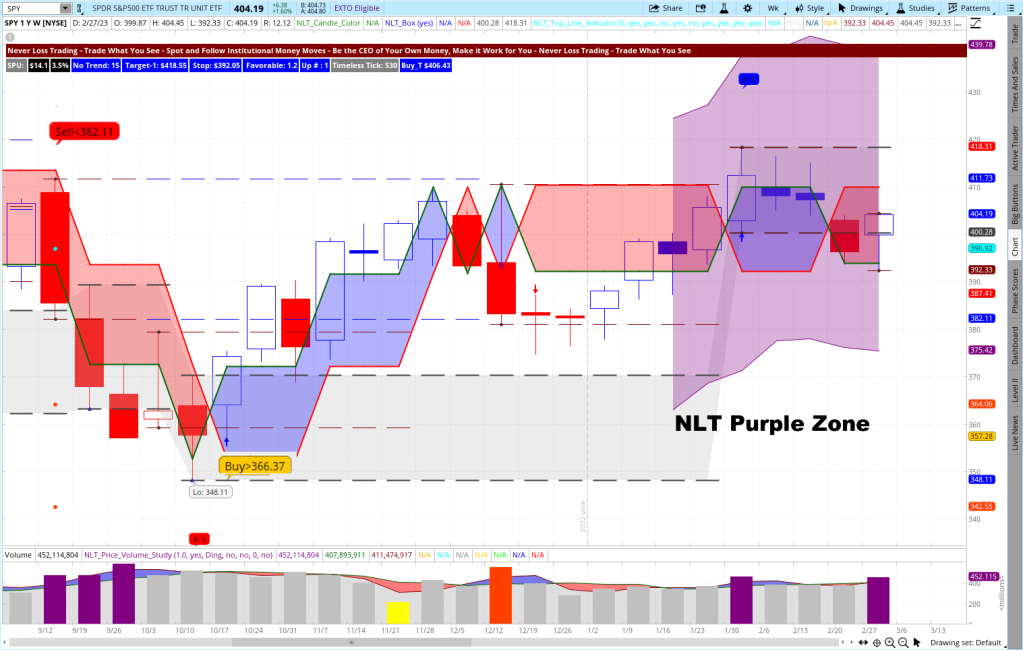
The chart shows that SPY remains in a purple zone starting the week of January 16, 2023, indicating that the market is not longer-term committed to a longer-term price direction. In the week of September 12, 2022, a short indication, Sell < $382.11, called for a short trading strategy that came to target in the next week. Our buy signal was confirmed in the week of October 17, 2022, leading to a strong upside price move that came to target on November 28, 2022.
However, when the market is not directionally committed longer-term, how do you start trading? First, you are scaling down in the decision-making timeframe. Next, you see a chart with NLT HF indicators that spell our crucial overall price turning points based on our volatility-adjusted short-term chart.
SPX, S&P 500 Index, NLT HF Price Turning Points

Imagine spotting and acting on the indicated price turning points; where would that get you?
In fourteen months, you had to act nine times to change the direction of your holdings. First, however, the question is:
Do you know suitable strategies to go long and short in any account (trade to the up or downside) without violating SEX regulations?
In our mentorships, we teach you the NLT Delta Force Concept, where you learn to either combine options with stocks or trade options on their own, knowing at any stage:
- Which strike price to pick
- Decide on the time of expiration
- Specify the maximum price for put or call options or change the options trading strategy from single options trade to debit or credit spreads
If you prefer day trading, the current time confronts you with radical price moves on time-based candles.
QQQ, 1-Hour NLT Top-Line Chart
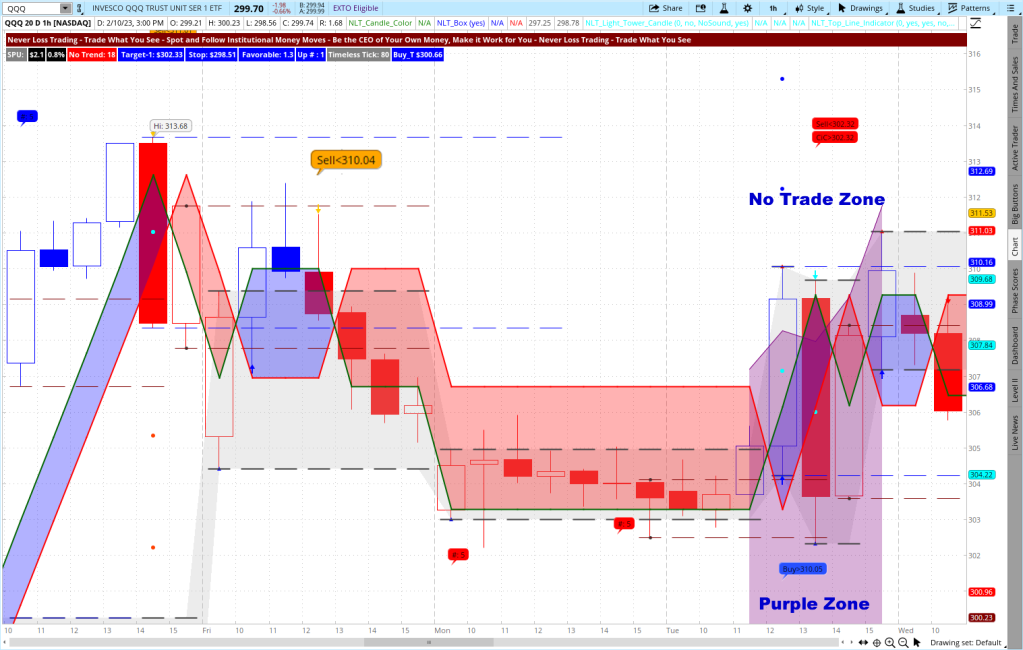
The 1-hour chart just had one trading opportunity in five days, expressing the difficulty time-based day traders face. In the NLT Purple Zone, opposite directional moves happened, and traders knew when to stay out of trades by having the zone.
We have a solution: the NLT Timeless Concept. System-based, we specify price increments to trade for and act on NLT signals purely price-based. Here are two chart examples that combine NLT Top-Line, Trend Catching, and Timeless. The first chart shows five potential trade situations; each spells out a price threshold like Buy > $4068 and provides a basis to trade for a price change of about $300 of the underlying contract. To execute a transaction, we operate with buy-stop bracket orders. A trade only goes to the exchange when in the price development of the next candle, the set threshold is reached and the order executed: Five trade situations were highlighted, and all met their desired target (gray dot on the chart). Non got stopped (red crossbar on the chart).
E-Mini S&P 500 Index Futures Example
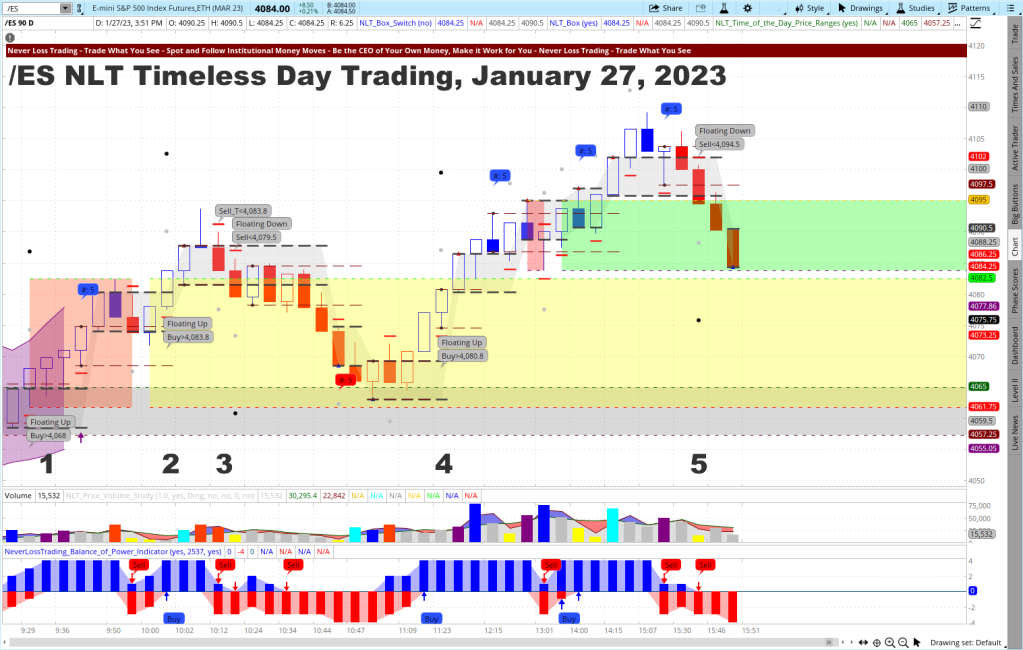
Next, we pick a crude oil futures example for the same day. The system also sets the price range to trade for, published daily. If you may, we will show you how our systems perform live:
Crude Oil Futures Example
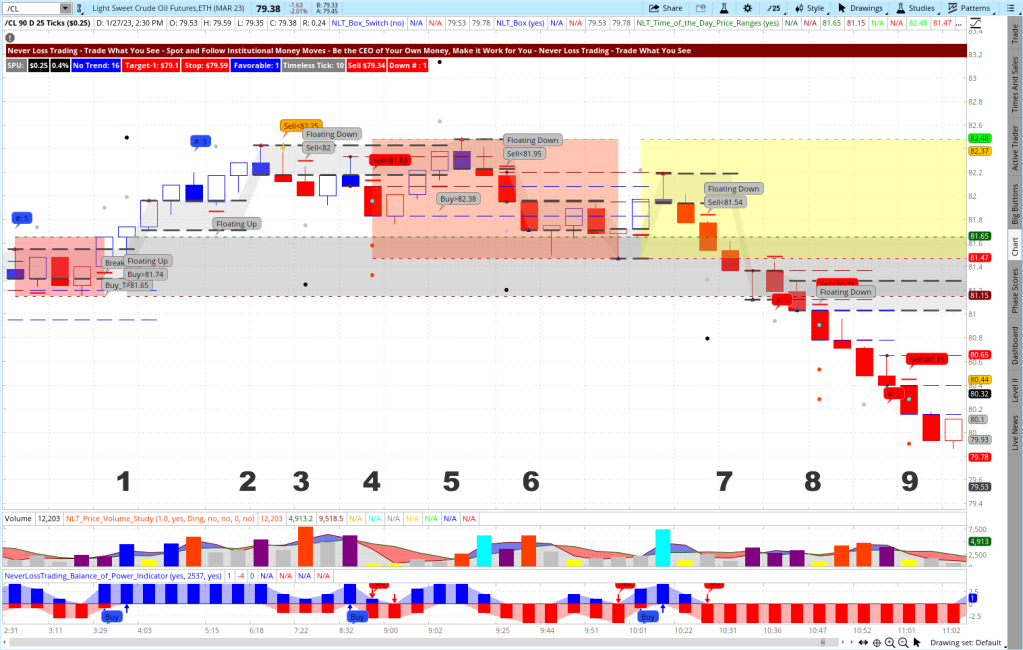
The Crude Oil Futures Chart shows nine trade situations with the same conditions and price thresholds. Accepting trades mechanically, without the evaluation to learn: six trade setups came to target (1, 2, 3, 5, 6, 7, 8, 9), and two got stopped (4, 5). Red crossbars identify the stop price level. Targets are at dots, and we only enter into a trade when the price threshold is ticked out in the price movement of the next candle.
Definitively, we have more recent charts and offer you a live demo: contact@NeverLossTrading.com Subj.: Day Trading
We hope we have demonstrated with the help of the game theory how you need skills and considerations in multiple dimensions to become a successful trader or investor. The following table summarizes the skills needed to succeed as a retail trader, and we support you in acquiring those. The issue to tackle: failing in one or more of the listed skills destroys your chance of making money. So make sure you get yourself checkmarks in the left column.
Trading and Investing Score Card
| # | Requirement | Desired | Usual | |||
| 1 | Following a System long-term | 100% | random decisions | |||
| 2 | System Probability | ≥ 65% | 51% to 55% | |||
| 3 | System-Defined Entries, Exits, Stops | 100% | situational | |||
| 4 | Risk Limiting Strategies | 100% | no risk control | |||
| 5 | Trade Finders (Scanners, Alerts) | 100% | random tips | |||
| 6 | Action Plan (when to trade, how often, position sizing, return goal) | 100% | random decisions | |||
| 7 | Risk/Reward Specification | 100% | nonexistent | |||
| 8 | %-Risk Money Management | 100% | nonexistent | |||
| 9 | Max Risk per Trade | 100% | nonexistent | |||
| 10 | Portfolio Hedging | 100% | none | |||
| 11 | Trading Journal and Review | 100% | nonexistent | |||
| 12 | Aware of Market-Impacting News | 100% | disregarded |
A dozen things to do. To make money trading, you must elevate yourself into the top 10% of retail traders. We are long-termers in the trading business and helped many to strive for their trading success and can assure you it is not coming without putting checkmarks on the left column of the above table.
To succeed in trading, you best work with an experienced coach and learn much about trading. Our #1 competitive advantage is the support and customer service we offer. We work one-on-one with you to specify what we teach to your specific wants and needs; hence, if your knowledge base is not expanding rapidly, you are doing something wrong. Ongoing education and mentoring are crucial to longevity in this business. Veteran traders have been through more ups and downs than you can imagine. So, experienced pros have probably experienced whatever you’re going through.
If you are ready to make a difference in your trading: We are happy to share our experiences and help you build your trading business. Trading is not a typical career, and you best learn from those who are long-term in this business to cope with the rollercoaster of the financial markets. We are here to help and provide feedback on what you might be doing right or wrong. Strive for improved trading results, and we will determine which of our systems suits you best. The markets changed, and if you do not change your trading strategies with them, it can be a very costly undertaking. The markets changed, and if you do not change your trading strategies with them, it can be a costly undertaking. However, you can make a difference with the right skills and tools!
Hence, take trading seriously, build the skills, and acquire the tools needed. Trading success has a structure you can create and follow.
Thomas Barmann (inventor and founder of NeverLossTrading)
Disclaimer, Terms and Conditions, Privacy | Customer Support


No comments:
Post a Comment